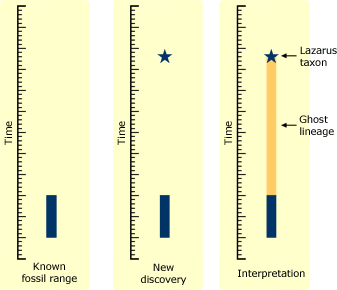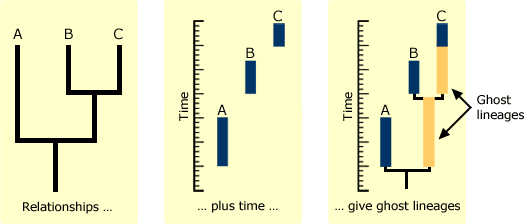Ghost lineages
A lineage is an unbroken chain of ancestors and descendants. In an evolutionary tree, the trunk, limbs, and branches are all lineages of organisms. A ghost lineage is a line of descent that has left no traces in the fossil record.
Wait a minute. If these lineages didn't leave any traces, how do we know that they exist?
Let's start with the most famous case of a ghost lineage in all of biology: the coelacanth. Coelacanths are lobe-finned fishes related to lungfish and to primitive tetrapods (animals with four limbs, like us). They have a long fossil record from the Devonian to the Cretaceous — about 300 million years. But no coelacanth fossils have been discovered in sediments younger than the Cretaceous, and scientists assumed that coelacanths had been extinct for the past 80 million years. Then in 1938 a living coelacanth was caught off the coast of Africa, and Berkeley biologists recently discovered a second population in Indonesia. So coelacanths obviously have been around for the past 80 million years, they just haven't left any fossils.

Left: Fossils of an organism are found in rocks of a limited age range. Middle: But then a fossil of the organism is discovered in rocks millions of years younger. Right: This would suggest that the organism did not go extinct but that there was a lengthy gap in the organism's fossil record. |
There are very good reasons for the absence of coelacanth fossils. The living species of coelacanth occurs only in relatively deep water around volcanic islands. Sediments from deep waters are preserved and exposed on continents, where paleontologists can get at them, but they are usually much older than 80 million years. By that time the continents were very close to their current positions, and there have been few opportunities for ocean-bottom sediments to be uplifted and exposed by erosion. These factors explain why coelacanths have an 80-million-year ghost lineage.
So the first case is a gap in the fossil record of a single group. We know that the group was around during the missing time represented by the ghost lineage because we have representatives on either side. A group which reappears after a long period of apparent extinction is known as a Lazarus taxon (right), after the biblical story of Lazarus, who was raised from the dead. The story of the coelacanth illustrates two characteristics that most Lazarus taxa share: they have a limited geographic range, and they live in environments where fossils rarely form. These factors allow them to survive for a long time without leaving many fossils.
Lazarus taxa are only half the story. They extend a ghost lineage forward in time. The other kind of ghost lineage extends a group's phantom record backward in time, and they are discovered by studying relationships.
Consider humans and chimpanzees. We are each other's closest relatives, or sister taxa, which means that we split from a common ancestor at the same time. Both fossils and genetic studies show that the divergence of the human and chimp lines must have happened about six or seven million years ago. But all of the fossils are on one side: ours. No chimpanzee fossils have ever been discovered. Still, we know that chimps have existed separately from humans for at least six million years, because (1) fossils of hominids (the human lineage) go back at least six million years, and (2) chimps are our closest relatives. If we split from a common ancestor at the same time, and if the human lineage is at least six million years old, then the chimp lineage must be that old as well. Like coelacanths, chimps have had few opportunities to enter the fossil record: they have a limited geographic range, and they live in tropical forests, where the acidic soil usually destroys bones within a few years.

Three taxa represented in the fossil record are hypothesized to be related to each other in a certain way. When the occurrences of these taxa in the fossil record are plotted against time, then the apparent gaps in the fossil record can be explained by ghost lineages. |
Ghost lineages play an important role in our understanding of evolution. Different hypotheses of relationships often imply different numbers and lengths of ghost lineages. For example, Protoavis from the Triassic of Texas was initially described as a primitive bird. But many paleontologists now think that the bones of Protoavis come from several different animals, including pseudosuchian (croc-line) archosaurs. Some of these pseudosuchians were surprisingly bird-like, such as the Upper Triassic rauisuchid Effigia, which ran on two legs and had a toothless beak. Pseudosuchians diversified in the Triassic, so if the bird-like bits of Protoavis belong to pseudosuchians there would be no long ghost lineage associated with it. On the other hand, if Protoavis is a bird, then it means that almost all groups of dinosaurs, including theropod clades like tyrannosaurs and dromaeosaurs, must also have been present in the Triassic, even though the fossils currently available show that these groups diversified much later. That would mean that we're missing most of the dinosaur fossil record, which is pretty unlikely.
On one hand, we know that ghost lineages are very common in the fossil record. Fossilization is a haphazard process, and most extinct species are only known from a handful of individuals, out of the billions or even trillions that must have existed. The chances that the fossil record will include the earliest and latest members of a species are very low, and if these end-members are not preserved, there will be a ghost lineage.
On the other hand, evolutionary biologists and paleontologists are just like other scientists in preferring simple explanations. Nature is not always simple, but the simplest explanations are often correct; even if they are wrong, they at least give us someplace to start working. In the case of ghost lineages, we prefer hypotheses of relationships that imply shorter ghost lineages. In the case discussed above, the hypothesis that Protoavis is a bird requires almost all of the other clades of dinosaurs to have originated in the Triassic. That means that not only are we missing most of the fossil record of all of those groups, but also our understanding of dinosaur ecology is seriously flawed. If tyrannosaurs originated in the Triassic, it is awfully strange that they waited more than 100 million years to become top predators. And so on for many other groups of dinosaurs. So either we have completely misunderstood the evolutionary history of dinosaurs … or Protoavis is not a bird. The latter hypothesis is definitely simpler, especially now that we know of other Triassic archosaurs that are superficially very birdlike, such as Effigia.

